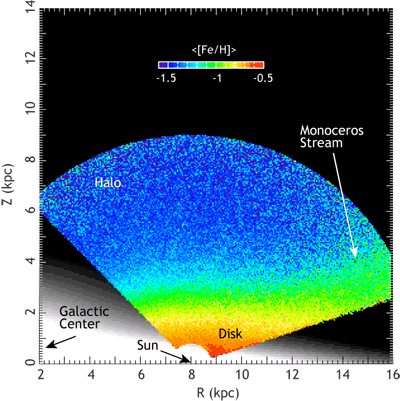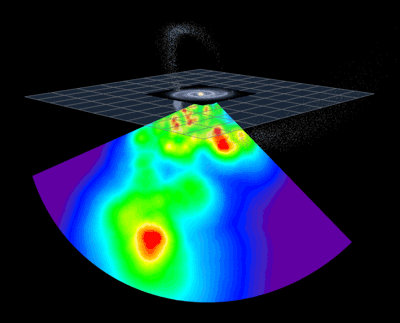 The largest detailed map of the chemical composition of Milky Way stars ever assembled. Such maps allow astronomers to decipher how our galaxy, the Milky Way, formed and how it evolved over the 13 billion years since its formation. For more details, please take a look at our press release.
 A demonstration of the large size of the Milky Way halo, relative to its disk, and of the rich substructure it contains. Based on RR Lyrae stars discovered by SDSS. For more details, please see paper by Sesar et al. (2010).
|
The current cosmological paradigm states that the Universe had its beginning in the Big Bang. Galaxies, the fundamental building blocks of the Universe, formed soon after the Big Bang. A major objective of modern astrophysics is to understand when and how galaxies formed, and how they have evolved since then. Our own galaxy, the Milky Way, provides a unique opportunity to study a galaxy in great detail by measuring and analyzing the properties of a large number of individual stars.
This research direction was recently revolutionized by the advent of modern large digital sky surveys, such as SDSS, 2MASS, GALEX and many others. Now we have accurate and diverse data for hundreds of millions of stars that form the basis for uniquely powerful statistical studies.
Generally, these studies can be viewed as comparing the distribution of hundreds of millions of points in a multi-dimensional space spanned by three spatial coordinates, three velocity components, metallicity and other measures of chemical composition (such as the abundance of so-called alpha elements) to our expectations based on models of galaxy formation and evolution.
My group has participated in a number of such studies, summarized in Ivezić, Jurić, & Sesar (2009) where references to more detailed papers (so-called “the Tomography series”) can be found. We had nice press coverage after this release.
This work based on main sequence stars was extended to reach the presumed edge of our Milky Way galaxy using RR Lyrae stars in Ivezić et al. (2000), Sesar et al. (2007), and Sesar et al. (2010). Of particular note is the discovery of one of the largest coherent structures on the sky, the Virgo Overdensity, as summarized in this press release.
These results have provided basis for an education and public outreach project by undergraduate students, described here.
|



































